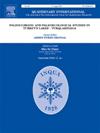爱沙尼亚西部两个粘土盆地Varve系列相互对比及古世变化
IF 1.8
3区 地球科学
Q3 GEOGRAPHY, PHYSICAL
引用次数: 0
摘要
对碎屑碎屑的研究已经取得进展,进一步加深了我们对更新世气候的理解,包括消冰过程。在这项研究中,我们提供了代表波罗的海东部爱沙尼亚西部不同盆地(Pärnu和Vigala)的两个阀门年表的相关性。通过古地磁长期变化的区域相关性,我们确定了爱沙尼亚沿海冰川消融的年代。在大约14.7 ~ 12.7 cal ka BP之间,爱沙尼亚境内的晚期Weichselian冰开始腐烂,随后出现了广泛的前冰期水体,这些水体随着冰缘的退缩和新的排水通道的开辟而发展。这反映在广泛分布的碎屑化粘土上。利用视觉和数值方法,我们将Pärnu盆地的两个年代学序列与Vigala盆地的一个新的532年代学序列进行了对比。我们的分析表明,冰近端Vigala盆地的裂谷形成比远端Pärnu盆地晚了大约140年,从而得出了大约670裂谷年的综合当地年代学。根据所研究的三个阀记录测量的自然剩余磁化相对赤纬显示,在最初的400阀年中,初始持续向东移动约90°,之后的值趋于稳定。这些古长期变化记录的区域对比表明,爱沙尼亚西部的粘土堆积大约在14.0 ~ 13.3 cal ka BP之间。更准确地说,我们的数据估计爱沙尼亚西部pandiva - neva和palalivere冰边缘复合体的年龄分别为13.9-13.8 cal ka BP和13.3 cal ka BP,因此,两者都比芬兰南部的新仙女木Salpausselkä冰边缘复合体早。这些结果为爱沙尼亚沿海的冰川消融提供了一个独立的年龄估计,并有望为区域冰川消融模式做出贡献。本文章由计算机程序翻译,如有差异,请以英文原文为准。
Varve series cross-correlation and palaeosecular variation from two clay varve basins in western Estonia
Work on clastic varves has advanced to further our understanding of Pleistocene climate including processes of deglaciation. In this study we provide a correlation of two varve chronologies representing different basins (Pärnu and Vigala) in western Estonia of the eastern Baltic Sea. Via regional correlations of palaeomagnetic secular variation we date the deglaciation of coastal Estonia. The decay of Late Weichselian ice from Estonian territory between about 14.7 and 12.7 cal ka BP was followed by extensive proglacial bodies of water, which developed in accordance to the receding ice margin and opening of new drainage routes. This is reflected in a wide distribution of clastic varved clays. Using visual and numerical methods we correlate two varve sequences from the Pärnu basin representing previously established 584-varve-year chronology and a new 532-varve-year sequence from the Vigala basin. Our analysis indicates that varve formation in the ice-proximal Vigala basin commenced approximately 140 years later than in the more distal Pärnu basin, yielding a combined local chronology of about 670 varve years. Natural remanent magnetization relative declination measured from the studied three varve records reveal an initial continuous eastward shift of approximately 90° during the first 400 varve years, after which values stabilize. Regional correlation of these palaeo secular variation records dates the clay accumulation in western Estonia to between ca 14.0 and 13.3 cal ka BP. More precisely, our data estimates the ages for the Pandivere-Neva and the Palivere ice-marginal complexes in western Estonia to ca 13.9–13.8 cal ka BP and younger than 13.3 cal ka BP, respectively, both thus, immediately predating Younger Dryas Salpausselkä ice-marginal complex in southern Finland. These results provide an independent age estimate for deglaciation of coastal Estonia and are expected to contribute to regional deglaciation models.
求助全文
通过发布文献求助,成功后即可免费获取论文全文。
去求助
来源期刊

Quaternary International
地学-地球科学综合
CiteScore
5.60
自引率
4.50%
发文量
336
审稿时长
3 months
期刊介绍:
Quaternary International is the official journal of the International Union for Quaternary Research. The objectives are to publish a high quality scientific journal under the auspices of the premier Quaternary association that reflects the interdisciplinary nature of INQUA and records recent advances in Quaternary science that appeal to a wide audience.
This series will encompass all the full spectrum of the physical and natural sciences that are commonly employed in solving Quaternary problems. The policy is to publish peer refereed collected research papers from symposia, workshops and meetings sponsored by INQUA. In addition, other organizations may request publication of their collected works pertaining to the Quaternary.
 求助内容:
求助内容: 应助结果提醒方式:
应助结果提醒方式:


